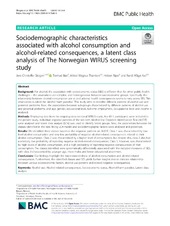| dc.contributor.author | Skogen, Jens Christoffer | |
| dc.contributor.author | Bøe, Tormod | |
| dc.contributor.author | Thørrisen, Mikkel Magnus | |
| dc.contributor.author | Riper, Heleen | |
| dc.contributor.author | Aas, Randi Wågø | |
| dc.date.accessioned | 2020-06-16T13:35:45Z | |
| dc.date.available | 2020-06-16T13:35:45Z | |
| dc.date.issued | 2019-10-24 | |
| dc.Published | Skogen JC, Bøe T, Thørrisen M, Riper H, Aas RW. Sociodemographic characteristics associated with alcohol consumption and alcohol-related consequences, a latent class analysis of The Norwegian WIRUS screening study. BMC Public Health. 2019;19:1364 | eng |
| dc.identifier.issn | 1471-2458 | |
| dc.identifier.uri | https://hdl.handle.net/1956/22631 | |
| dc.description.abstract | Background: For alcohol, the association with socioeconomic status (SES) is different than for other public health challenges – the associations are complex, and heterogeneous between socioeconomic groups. Specifically, the relationship between alcohol consumption per se and adverse health consequences seems to vary across SES. This observation is called the ‘alcohol harm paradox’. This study aims to describe different patterns of alcohol use and potential problems. Next, the associations between sub-groups characterized by different patterns of alcohol use and potential problems, and age, gender, educational level, full-time employment, occupational level and income is analysed. Methods: Employing data from the ongoing cross-sectional WIRUS-study, N = 4311 participants were included in the present study. Individual response patterns of the ten-item Alcohol Use Disorders Identification Test (AUDIT) were analysed and latent class analysis (LCA) was used to identify latent groups. Next, the associations between the classes identified in the best fitting LCA-model and sociodemographic factors were analysed and presented. Results: We identified three classes based on the response patterns on AUDIT. Class 1 was characterised by low-level alcohol consumption and very low probability of negative alcohol-related consequences related to their alcohol consumption. Class 2 was characterised by a higher level of consumption, but despite this, class 2 also had a relatively low probability of reporting negative alcohol-related consequences. Class 3, however, was characterised by high levels of alcohol consumption, and a high probability of reporting negative consequences of their consumption. The classes identified were systematically differentially associated with the included measures of SES, with class 3 characterised by younger age, more males and lower educational attainment. Conclusions: Our findings highlight the interconnectedness of alcohol consumption and alcohol-related consequences. Furthermore, the identified classes and SES yields further insights into to intricate relationship between various socioeconomic factors, alcohol use patterns and related negative consequences. | en_US |
| dc.language.iso | eng | eng |
| dc.publisher | BioMed Central | eng |
| dc.rights | Attribution CC BY | eng |
| dc.rights.uri | http://creativecommons.org/licenses/by/4.0/ | eng |
| dc.subject | Alcohol use | eng |
| dc.subject | Alcohol-related consequences | eng |
| dc.subject | Socioeconomic status | eng |
| dc.subject | Alcohol-harm paradox | eng |
| dc.subject | Latent class analysis | eng |
| dc.title | Sociodemographic characteristics associated with alcohol consumption and alcohol-related consequences, a latent class analysis of The Norwegian WIRUS screening study | eng |
| dc.type | Peer reviewed | |
| dc.type | Journal article | |
| dc.date.updated | 2020-01-29T11:54:40Z | |
| dc.description.version | publishedVersion | |
| dc.rights.holder | Copyright 2019 The Author(s) | eng |
| dc.identifier.doi | https://doi.org/10.1186/s12889-019-7648-6 | |
| dc.identifier.cristin | 1747729 | |
| dc.source.journal | BMC Public Health | |
| dc.relation.project | Universitetet i Stavanger: IN-11551 | |
| dc.relation.project | Norges forskningsråd: 260640 | |

